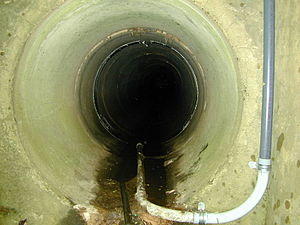 |
| Image courtesy Wikipedia |
Imagine yourself going to the meat counter to pick up a pound of hamburger. (Vegetarians, bear with me on this one). Anyway--you place your order with the butcher, and he comes back and hands you a container that weighs as much as a small newborn.
"Excuse me... I asked for a pound of the ground chuck", you point out.
"That is a pound", he said, pointing to the label. Sure enough, the printed label states that the meat weighs a pound. He whispers, "actually, it's about a half an ounce over--but I only charged you for a pound".
You examine the box, pick it up again, and say to yourself, "this has got to weigh five or six pounds." Noting that the box is unusually sturdy, you ask the butcher the obvious question--"if there's only a pound of hamburger, how much does this box weigh?"
"The box? Oh, it's five pounds."
"Five pounds?"
"Yeah. Protects the meat in shipment. New joint USDA-NTSB regulations. Has the buff strength of a locomotive, I hear."
"What for? I'm gonna throw this stuff on the grill as soon as I get back home!" you protest.
"Don't ask me, pal--I just work here. I don't make the rules; I just do what I'm told. Anything else I can get for you today?"
Weight Ratios
This obviously far-fetched scenario is intended to illustrate the concept of a weight ratio. The weight ratio of a container or vehicle is the ratio of the vessel, divided by the weight of whatever it is being transported or stored--whether it be a pound of ground beef, or 150 pounds of human being. The idea of using a 5-pound container to transport a pound of meat is obviously ridiculous.
But in the passenger transportation field, a 5:1 ratio--five pounds of container for every pound of person, is actually quite unremarkable. Non human-powered vehicles need to transport themselves; requiring motors of some sort; and they also need a power source--fuel, batteries, external power--both of these things add significant weight. We also expect them to travel at speeds at which the occupants may be endangered by a collision if not adequately protected, to be weatherproof, and to have other creature comforts that don't make the journey unbearable for the persons riding them. And we expect them to be flexible in the number of passengers they can carry, and to be capable of carrying luggage or other freight.
As a result, unless one is riding a bicycle, a person's typical ride will weight in at several times what the person weights.
Typical values
Let's quickly look at typical weight ratios involved in transportation; first including self-propelled, fully enclosed vehicles. We'll assume people weigh 150 pounds (the average adult weight is actually a bit higher) in all our calculations. It makes the math easier, and I'm lazy. While I've generally tried to incorporate SI units in my posts, I'll neglect that courtesy this time around, also because I'm lazy.
For passenger cars, there's quite a wide variety in both weight and passenger capacity. Many larger cars and SUVs weigh two tons or more; and it's not unheard for people to commute in vehicles such as a Ford F350 pickup, which approaches 5 tons. If we assume a typical large car, weighing at two tons, and a single occupant, that gives us a weight ratio of about 27:1. Most subcompacts (i.e. Honda Civic couples, Mini Coopers) check in at about 2500 pounds, for a ratio of 16.7:1. A SmartCar Fortwo, the smallest production car you'll commonly find in the US, has a curb weight of 1600 pounds (and seats only a single passenger); for a ratio of just under 11:1. If you carpool, the weight ratio drops dramatically--four commuters in a Civic will produce a weight ratio of just over 4:1. These weights all exclude fuel, although cars are heavy enough by themselves that there is seldom a need to consider wet vs. dry weight.
Public transit vehicles vary widely with occupancy, but not so much between vehicles. A good rule of thumb for a FRA-exempt large transit vehicle (a 40' bus or larger, or a streetcar, LRV, or high-platform metro train) is that it will weight 1000 pounds per linear foot--this rule works surprisingly well for back-of-the-envelope calculation of weights. Two other rules of thumb which also work pretty well for many transit vehicles is a design-load passenger capacity of 1.5 passengers per foot, and a crushload capacity of 2.5 passengers/foot. Plugging in our 150-pound weight estimate, this reveals that many transit vehicles have weight ratios of about 4.4:1 at design load, 2.7:1 at crush loads. That said, transit vehicles do rather poorly at typical social-service-route loads--if there's 10 people on a 40' bus (weighing in at 20 tons), that's the same weight ratio as a single rider in a large car. (Fortunately, as discussed below, the bus has a higher per-passenger fuel economy than the car, even n this dismal case).
What about two-wheelers? Motorbikes typically have wet weights (weight of the bike plus fuel and fluids and battery) ranging from 300 pounds for a 150cc standard up to 600 pounds or more for a big fat Harley cruiser. These numbers correspond to ratios of 2:1 and 4:1 respectively. On the other hand, decent bicycles can be found weighing 20 pounds or less (and people will spend tons of money to get down to 15 pounds)--now we're talking ratios under 1:5, or 0.2:1.
What to make of all of this?
Weight ratio has a direct impact on the fuel efficiency of a given mode--though the effect isn't quite as dramatic as one might expect--a typical motorbike has a fuel economy in the range of 2x-4x a typical passenger car; for instance--a much smaller multiplier than raw weight ratio would predict. Likewise, transit vehicles actually do better on energy efficiency vs autos than weight ratios would predict; a full 40' bus will have better energy use per passenger than a full Honda Civic. (Many transit critics claim busses are less efficient than cars based on average occupancy--most bus agencies have runs or entire routes which are far from full; however in that case, the marginal cost of an additional passenger is almost zero). While a 40' bus has a weight ten times or more a typical car, it doesn't have an engine ten times as powerful.
However, excluding the case of the bicycle (or of walking, which has a weight ratio of essentially zero), even the best examples of motorized transport have ratios greater than 2:1--for every pound of passenger to be moved, at least two pounds of vehicle must be moved. And this represents a whole lot of energy which is wasted, every day.
A blog post by Brad Templeton suggests that the wave of the future might be in "ultralight vehicles" (not to be confused with ultralight aircraft)--self-powered vehicles designed for commuting applications, which weigh more than a bicycle but considerably less that a modern motorcycle. Mopeds come close to this goal, generally weighing no more than 200 pounds or so. Brad seems to be thinking of some sort of self-stabilizing, motorized bicycle or tricycle with a fiberglass shell (a design which in various forms has been around for years).
There's also lots of discussion of designing lighter large transit vehicles; as it is with larger vehicles that one is more likely to be able to pull out weight without sacrificing things like structural stability. Prototypes busses and trains weighing half of what conventional vehicles weigh have been shown, although many of these do not yet meet relevant safety standards, and such vehicles do not seem to yet be in production, let alone in widespread use. (For exclusive-ROW closed BRT/LRT systems, waiver of these standards might be a possibility).
But the bottom line is: The world is entering an era (and may be there already) in which energy is increasingly expensive to produce. That transportation of people frequently requires that the vehicle weighs several times what the passengers weigh--that we need to haul so much deadweight around to go somewhere--is a Big Problem. And solutions to this problem will be increasingly important in the future.











